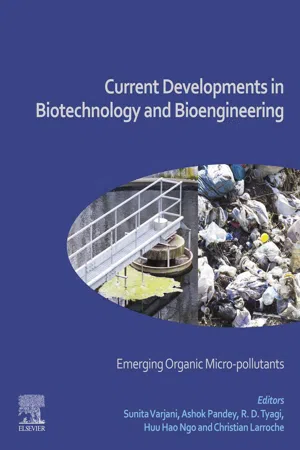
Current Developments in Biotechnology and Bioengineering
Emerging Organic Micro-pollutants
Sunita Varjani,Ashok Pandey,R. D. Tyagi,Huu Hao Ngo,Christian Larroche
- 586 pages
- English
- ePUB (mobile friendly)
- Available on iOS & Android
Current Developments in Biotechnology and Bioengineering
Emerging Organic Micro-pollutants
Sunita Varjani,Ashok Pandey,R. D. Tyagi,Huu Hao Ngo,Christian Larroche
About This Book
Current Developments in Biotechnology and Bioengineering: Emerging Organic Micropollutants summarizes the current knowledge of emerging organic micropollutants in wastewater and the possibilities of their removal/elimination. This book attempts a thorough and exhaustive discussion on ongoing research and future perspectives on advanced treatment methods and future directions to maintain and protect the environment through microbiological, nanotechnological, application of membrane technology, molecular biological and by policymaking means.
In addition, the book includes the latest developments in biotechnology and bioengineering pertaining to various aspects in the field of emerging organic micropollutants, including their sources, health effects and environmental impacts.
- Includes testing methods for the analysis and characterization of emerging organic micropollutants in wastewater
- Discusses the environmental impact and health hazards of emerging organic micropollutants in wastewater
- Provides a useful guide to identify priority areas of research demand in the remediation/removal of emerging organic micropollutants
Frequently asked questions
Information
Sustainable management and treatment technologies for micro-pollutants in wastewater
b School of Environment, Tsinghua University, Beijing, China
c Shanghai Key Laboratory of Atmospheric Particle Pollution and Prevention (LAP3), Department of Environmental Science and Engineering, Fudan University, Shanghai, China
d Gujarat Pollution Control Board, Gandhinagar, India
Abstract
Keywords
1 Introduction

2 Occurrence of micro-pollutants in wastewater
| Typical micro-pollutants | Countries | Sources | Concentration (μg/L) | References |
|---|---|---|---|---|
| Pharmaceuticals | ||||
| Acetaminophen (analgesic) | Columbia, United States, Taiwan | Municipal wastewater, hospital wastewater, drug production facility, sewage treatment plant | 0.079–417.5 | [5–7], [8] |
| Amoxicillin (antibiotics) | Hongkong | Sewage treatment plant | 0.261 | [9] |
| Ampicillin (antibiotics) | Greece | Sewage treatment plant | 1.805 | [10] |
| Azithromycin (antibiotic) | Columbia | Municipal wastewater | 6.32 | [5] |
| Carbamazepine (antiepileptic) | Columbia, United States, Taiwan | Municipal wastewater, sewage treatment plant | 0.07–0.097 | [5,7] |
| Chloramphenicol (antibiotics) | Spain | Sewage treatment plant | 11, 67 | [7,11] |
| Ciprofloxacin (antibiotic) | United States, Columbia | Sewage treatment plant, municipal wastewater | 2.29–67 | [5,7] |
| Ibuprof... | ||||
Table of contents
- Cover image
- Title page
- Table of Contents
- Copyright
- Contributors
- Editors Biography
- Preface
- Chapter 1: Sustainable management and treatment technologies for micro-pollutants in wastewater
- Chapter 2: Occurrence and human health risk of micro-pollutants—A special focus on endocrine disruptor chemicals
- Chapter 3: Micro-pollutants in surface water: Impacts on the aquatic environment and treatment technologies
- Chapter 4: Methods for the analysis of micro-pollutants
- Chapter 5: Constructed wetlands for the removal of organic micro-pollutants
- Chapter 6: Multibarrier approach for the removal of organic micro-pollutants
- Chapter 7: Heterogeneous photocatalysis for the removal of pharmaceutical compounds
- Chapter 8: Biotransformation of organic micro-pollutants in biological wastewater
- Chapter 9: Modeling organic pollutant degradation kinetics
- Chapter 10: Membrane bioreactors for the removal of micro-pollutants
- Chapter 11: Membrane distillation for the removal of micro-pollutants
- Chapter 12: Removal of organic micro-pollutants by membrane filtration
- Chapter 13: Advanced oxidation processes for the removal of pesticides
- Chapter 14: Retention of organic micro-pollutants by sorption processes
- Chapter 15: Removal of organic micro-pollutants using filamentous fungi
- Chapter 16: Removal of organic micro-pollutants by anaerobic microbes and enzymes
- Chapter 17: Degradation of organic micro-pollutants by ultraviolet radiation
- Chapter 18: Removal of emerging micro-pollutants from pharmaceutical industry wastewater
- Chapter 19: Ecotoxicological effects of organic micro-pollutants on the environment
- Chapter 20: Removal of contaminants of emerging concern by microalgae-based wastewater treatments and related analytical techniques
- Chapter 21: Nanofiltration and reverse osmosis processes for the removal of micro-pollutants
- Index